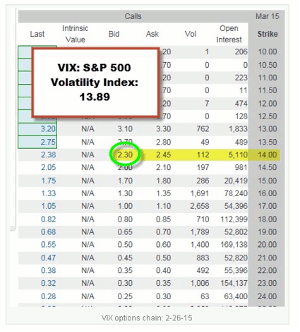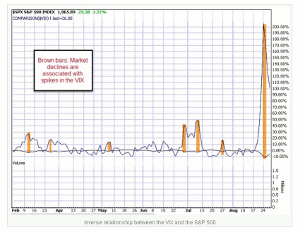Given that market volatility has recently risen exponentially, a number of options traders may be considering the use of volatility options as a means of enhancing portfolio returns, so options expert Alan Ellman, of TheBlueCollarInvestor.com, offers a comparison of VIX options to standard equity options.
Option returns play a major role in our covered call writing and put-selling strategies. Mega-returns can be quite enticing but also very dangerous. Recently, with market volatility rising exponentially in response to global economic concerns, a few of our members have inquired about using volatility options (VIX) based on the S&P 500 (SPX) (SPY) volatility as a means of enhancing portfolio returns. The reason these securities caught the eye of our members is the generous potential returns as shown in the screenshot below (before the current spike in volatility) which represents a 16-trading day return:
The VIX, or CBOE Volatility Index, also known as the investor fear gauge, measures the market’s expectation of 30-day volatility based on option pricing. It is a measure of market risk.
The 3-week return appears to be $230.00/1389.00 = 16.6%. In addition to this incredible opportunity (maybe not), the VIX was quite low in February 2015 and reasonable expectations of a spike up soon was on the table. So goes the attraction and the thinking. Like most incredible opportunities, if it seems too good to be true, it usually is.
VIX options are a completely different type of security from the typical equity options we trade. The recent volatility related to issues in Greece, Russia, Japan, and China is a red flag as to the risk we are taking when predicting market assessment of future volatility. That doesn’t even factor in the Fed watch for a future rate hike in short-term interest rates. We would have to master a whole new set of parameters before it would make sense to consider using VIX options, although I do see a potential use for them by retail investors (which I will discuss later in this article). First, let’s explore the unique qualities of VIX options compared to standard equity options:
Comparison of VIX Options to Standard Equity Options
- There is no underlying security to buy because it is based on futures contracts for an index. Therefore, covered call writing is eliminated
- Since the options are based on VIX futures contracts, it may not track the actual VIX accurately. A large spike or drop in the VIX will not be adequately represented by these options
- You must trade VIX options in a margin account and therefore cannot be used in a self-directed IRA account
- These are European style options compared to the American style options we are used to. This means that they cannot be exercised until expiration Friday
- A higher level of trading approval is required than for covered call writing
- Obtaining information on the Greeks is difficult because these options are based on futures and not the actual index. Many brokerages have inaccurate Greek stats on these securities
- These options expire on a Wednesday, not a Friday as we are used to
- Huge returns always mean huge risk. There are no free lunches out there.
Discussion
Since we cannot use these options for covered call writing and the parameters are so different than equity options, the use of this strategy in our options portfolio should be reserved for more sophisticated investors who have studied and practiced the nuances and differences of VIX options compared to equity options. Also, one’s personal risk tolerance should align with the high-return/high-risk profile of VIX options.
Possible Use of VIX Options by Retail Investors
This is just a thought, not necessarily a recommendation: Since the VIX historically is inversely related to the S&P 500 (market goes up, VIX goes down and vice versa), buying deep out-of-the-money VIX call options can serve as a hedge for a portfolio in much the same way buying puts can protect a downturn in our portfolios. The chart below shows the inverse relationship between the VIX and the S&P 500 as of August 27, 2015:
By Alan Ellman of TheBlueCollarInvestor.com























